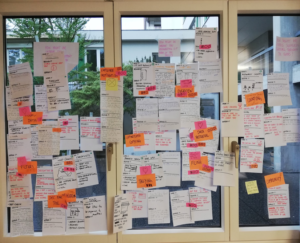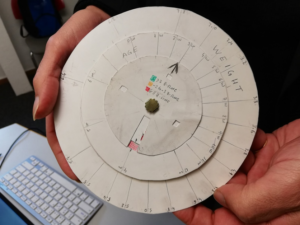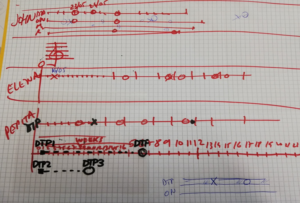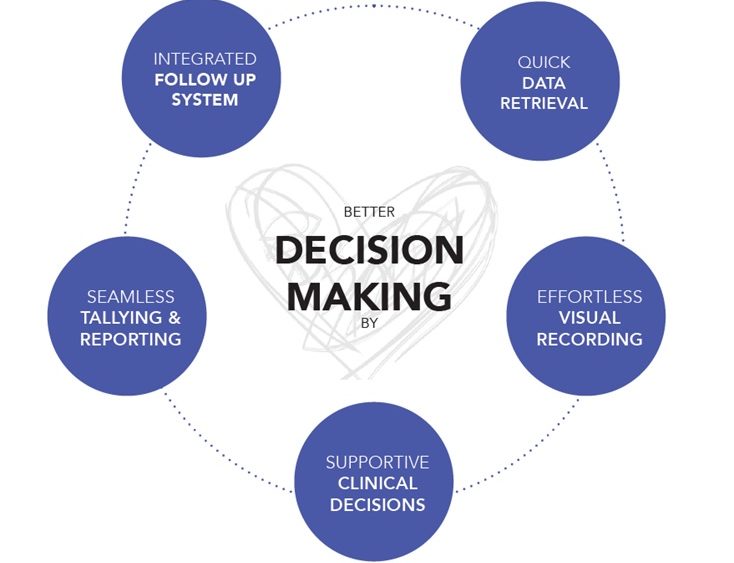PHISICC has been an advocate of co-creative processes for a long time. Just recently we had a fantastic week being fully immersed in what that feels like when doing human-centred design. Read on to find out what happened.
Watch the team in action – a short video
“This workshop brought new light to the project by putting decision making not only at the centre of the health information system, but also at the centre of the human experience to make decisions that make the difference between life and death. It was worthwhile to be patient and to engage with the process that Damaris led brilliantly, being able to extract from each of us our most thoughtful ideas. I am convinced that the Co-Creation Groups in Côte d’Ivoire, Mozambique and Nigeria will enjoy such a process and will get astonished, as we got, with the outputs of such workshops.” – Xavier Bosch-Capblanch, PI
Bringing the abstract into a physical form

Window of ideas: Challenge areas and design opportunities
Two weeks ago, the Basel PHISICC team spent an intensive 5-days collaborating with human-centred design experts, Damaris and Melanie, from Sonder Design.
Together, we reflected on all the PHISICC findings and set to work on articulating what the key ‘challenge areas’ are and what the main ‘design opportunities’ might be for paper-based health information tools.
Ideas ranged from the simple and pragmatic (e.g., checklists to support clinical decision making) to more large scale visual representations (e.g., health service delivery system recreated as a functional wall). The emphasis at this stage was just to create ideas as freely as possible!
“I was impressed by the positive energy and all my expectations were fulfilled. I really liked to go back to the results from the HIS characterizations of Côte d’Ivoire, Mozambique and Nigeria and the strong focus on the health workers needs. Of course, we could only anticipate health workers needs and benefits, which made the later hands on prototyping activities a bit difficult for me. Therefore I am looking forward to meeting with the co-creation groups from the three countries in a few days in Maputo, Mozambique and get their feedback, inputs and thoughts about further improvements!” – Meike Zuske, PHISICC SwissTPH
Identifying priority design concepts
All of the ideas were posted onto a wall and together we decided how they could be grouped into higher level design ‘concepts’. Categorisation was based on the different features of the ideas and where they might overlap (e.g., use of visual data, enabling effortless copying).
The moment when we confirmed that we had five ‘priority concepts’ was really quite enlightening. Whilst they seem simple, the concepts encapsulate a lot of complexity and put it into a more manageable form. Critically, these concepts reflect the essence of the evidence gathered during earlier phases of PHISICC and provide a very clear definition of what better decision making is all about.
Human-centred design has enabled PHISICC to confidently say that better decision making can be supported in resource-constrained, primary health care settings through:
- Quick data retrieval
- Effortless visual recording
- Supportive clinical decisions
- Seamless tallying and reporting
- Integrated follow-up system
Prototyping priority concepts
“There is a need to continually create new ideas and build on those of others – this is exciting but also requires a lot of listening and processing; you have to keep an open mind. I think the hardest things were not always reaching a point of certainty and always understanding everyone’s ideas to be clear about what made sense and what didn’t. There is a lot of experimentation but as the days passed, there was an increasing sense of having methodically brought the most relevant areas into focus and increasing confidence that the process was working. The prototyping and having to explain your ideas really help to clarify what looks most promising.”
– Caitlin Jarrett, PHISICC SwissTPH

Prototyping: Child growth wheel
Guided by the priority concepts, the team spent several days building and testing basic prototypes.
The workflows of two primary health care areas, vaccination and sick child, provided the context for this activity.
We tried to align our new prototypes with the expected processes and develop them in order to support the functions of the priority concepts.
These activities were much harder than they sound but we got there in the end!
Next iterations

Prototyping: Vaccination timeline
Next week we will be travelling to Maputo in Mozambique to meet with all the PHISICC collaborators from Nigeria, Côte d’Ivoire and Mozambique.
This is a much anticipated gathering because it will enable the design of different tools to be shaped in true context and by those who may ultimately use them.
As with the last workshop in Côte d’Ivoire, we hope that this session will enable a lot of energetic, focused, cross-country exchange which participants will find beneficial.
We can’t wait to see PHISICC design taken to the next level!
Next stop Maputo!



Comments are closed.